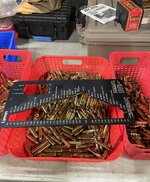I'm pepping brass for basic AR… nothing special and I'd count on it to run everything that fits …. All these cheap ones are way gassy…
Using case length template for quick reference (I don't usually process this much) but I have one. SAAMI max.
The cases that are a hair over I'm just throwing towards 300 blk cartridges. So not important now…. But
How are y'all measuring so much 5.56? I know a lot of you are pumping out a ton.
Does it really matter for plinking? I mean the regular ole AR should run them right? Or are you trimming each one? Or what is acceptable?

Using case length template for quick reference (I don't usually process this much) but I have one. SAAMI max.
The cases that are a hair over I'm just throwing towards 300 blk cartridges. So not important now…. But
How are y'all measuring so much 5.56? I know a lot of you are pumping out a ton.
Does it really matter for plinking? I mean the regular ole AR should run them right? Or are you trimming each one? Or what is acceptable?













